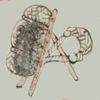ichcatl (CST39)
This painting of the simplex glyph for the term ichcatl (rams) shows the top part of the animal with its horns curving under. Below the ram is a banderole where it is written alphabetically as “diezmo” (a loanword from Spanish meaning the “tithe”). Kevin Terraciano (Codex Sierra, 2021, 158) interprets this as a 50-peso tax paid on property for the purchase of sheep. In earlier pages of the codex, the reader will find an entry about the establishment of a ranch for raising sheep that involved the purchase of 100 rams.
Stephanie Wood
In our Online Nahuatl Dictionary we have an example of a pueblo in the Tetzcoco area having to pay a hefty tithe in 1638 in the form of 32 fanegas (52 to 55 liters or 75 to 125 kilos) of maize kernels (seed).
Stephanie Wood
1550–1564
Jeff Haskett-Wood
diezmos, tasaciónes, animales, carneros, propiedades, iglesia católica

ichca(tl), rams, https://nahuatl.wired-humanities.org/content/ichcatl
carnero
Stephanie Wood
Códice Sierra-Texupan, plate 39, page dated 1561. Origin: Santa Catalina Texupan, Mixteca Alta, State of Oaxaca. Kevin Terraciano has published an outstanding study of this manuscript (Codex Sierra, 2021), and in his book he refers to alphabetic and “pictorial” writing, not hieroglyphic writing. We are still counting some of the imagery from this source as hieroglyphic writing, but we are also including examples of “iconography” where the images verge on European style illustrations or scenes showing activities. We have this iconography category so that such images can be fruitfully compared with hieroglyphs. Hieroglyphic writing was evolving as a result of the influence of European illustrations, and even alphabetic writing impacted it.
https://bidilaf.buap.mx/objeto.xql?id=48281&busqueda=Texupan&action=search
The Biblioteca Digital Lafragua of the Biblioteca Histórica José María Lafragua in Puebla, Mexico, publishes this Códice Sierra-Texupan, 1550–1564 (62pp., 30.7 x 21.8 cm.), referring to it as being in the “Public Domain.” This image is published here under a Creative Commons license, asking that you cite the Biblioteca Digital Lafragua and this Visual Lexicon of Aztec Hieroglyphs.





